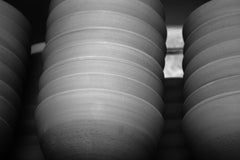The Studio
The Pots
All the work is hand thrown and turned stoneware. No machines or moulds are used and the traditional techniques have taken many years to perfect. The pottery does not try to mimic the past but draws on skills rarely practiced today. Combined with high temperature stoneware glazes, fine brushwork, wax resist and glaze trailing, the finished pots with rich copper red and cobalt blue glazes are both functional and decorative whilst still having a contemporary look. On the Specials range, gold lustre is hand decorated on to the stoneware pot and then fired again, adding a luxurious opulence not normally found on studio pottery. The glazes and pigments are made up from raw materials in the pottery and are fired in a gas kiln to over 1300° Celsius. This fuses both clay and glaze together in an impenetrable bond, giving the pottery both its brightness and its depth of colour. Although decorative, the pots have been designed to be used and are oven and dishwasher safe.

The Pottery and Selborne
The attractive village of Selborne and its beautiful countryside is famous for its association with the eighteenth century naturalist Gilbert White. The parish of Selborne also includes the neighbouring villages of Blackmoor and Oakhanger, each with their own unique history. If you would like anything that is not available on the website shop, please feel free to call or email us. We can also make bespoke items at your request.

Please view the short video below to watch Selborne Pottery in action.
The History of Selborne Pottery as told by Robert Goldsmith
The seedlings for the formation of Selborne Pottery emerged many years ago. As a child I had access to the raw material because my mother Eve Goldsmith, an artist, used to sculpt using a coarse stoneware clay. Most children enjoy the immediacy of creating with clay, as little fingers prodding and wooden tools sculpting are as close to a pig in muck as one can get. Add to that water and the encouragement of adults around me, and it was a winning combination. The clay theme continued into school, where my pottery teacher, Naomi Hoyland, noticed my interest and encouraged my endeavours. She was a very fine potter and calligrapher in her own right and I think was pleased to have such a young pupil who seemed to have a particular affinity with clay and whose preference was to learn to throw on the wheel rather than play football like most of my other friends. (A teacher at school was often amused to find this young lad, his blazer covered in clay, arriving dishevelled from the Pottery Department.) At the time, as now, it seemed quite normal to be spending my school breaks in the pottery rather than playing sport. I have always been more of an independent outdoors person than a team sportsman, and am usually to be found walking my trusty hound Sacha during a daytime break from potting on one of the many beautiful walks in and around Selborne.
During the summer holidays between my O and A levels, I went to the Loire in France to work for an English potter called Owen Watson. He was an eccentric academic and had once been a patient of my grandmother in Cambridge. He had chosen to live his life in rural France and pared everything down to its simplest form. His home was a small farmstead surrounded by peacocks, turkeys and chickens (some of which used to roost on the backs of the turkeys). The vain peacocks woke me up in the morning by tapping on my window. Daily duties involved milking the goats, from which the most amazing fromage frais and creamy cheese coated in ash were created. Other duties included splitting oak logs for the wood kiln, which was fired once a month. The ash from a wood firing binds to the outside of a red-hot pot in the kiln and forms a very beautiful and distinctive glaze. It is more of an Oriental aesthetic, but some of the best potters in Britain and abroad have adopted this form of firing. Owen Watson also used wood ash in glazes that he applied to the pots before the glaze firing. Some of the ash was from Provence and included lavender, producing a very beautiful glaze – lavender-coloured with the addition of a little cobalt. The reason for mentioning this is because these early childhood experiences helped form the potter I was to become later.
A one-year Art foundation course in Liverpool was followed by a very happy three years of Art School in Farnham, specializing in Ceramics. After completing my degree, I spent several months on the island of Bornholm (Denmark) working for a family pottery in Ronne, the main town on the tiny windswept island. Following Christmas back home, I made the decision in 1985 to have a go at starting my own Pottery at Neatham Mill, near Holybourne. I never forgot the slight look of incomprehension on my older sister’s face as she came to visit what was essentially a hovel of a chicken-shed in the grounds of the medieval Mill. My workshop had no heating, electricity, water or floor, all of which, in my very amateur way, I installed. My heating was an ancient wood-burning stove that I was given by my grandmother and the hot water came from a very unsafe Belling wall-heater (which made the whole supply and the metal sink in the Pottery live). I later found out that there was no earth wire.
Eight years of hard work showing at Craft Fairs and Exhibitions and selling to Craft Galleries established Neatham Mill Ceramics as the forerunner of Selborne Pottery. Gallery owners would tramp across the long grass to my workshop and choose pots fresh from the kiln. My neighbour at the Pottery was a very creative blacksmith, Paul Jobst, whose melody of hammering soft red-hot iron on his anvil was a welcome change from the roar of the gas-burners from my propane-fired kiln. When Paul bought a massive power-hammer, the melody became more of a heavy-hooves soft thud. Those early days, although not flush with funds, were happy as relationships were established and, being surrounded by other creative people, mostly fresh from art school, there was a buzz in the air of new businesses being started where the energy and naivety of youth meant anything could happen. It was at this time that I took on my first apprentice. Peter Bodotsky was from Budapest and was the son of an artist too. His mother, an English lady, had fallen in love with a bohemian painter from Hungary and had defected to the East at a time when most people were trying to escape to the West – but that is another story. Peter was my apprentice for three years and became a very fine potter in his own right. He left to do his own degree in Ceramics at Goldsmiths College, but the course was closed just before he started. (He is now an airline pilot.)
After eight years at Neatham Mill, the workshop had become too small and the opportunity to move to Selborne arose after a chance meeting with Tom Yendell at a party at the Mill. He had bought the workshop and several surrounding buildings on the Plestor and wanted to start a small art community, including, as it turned out, a pottery. In 1992 Tom set up the MFPA (Mouth and Foot Painting Artists) Gallery and soon afterwards I acquired the workshop from him and established the Pottery, once work to the dilapidated buildings had been completed. Quite by chance, it was at this point that mains gas arrived in the village, so I was lucky in many ways. My pots rely on a ‘reduction atmosphere’ in the kiln that can only be achieved with gas and not electricity.
I have always worked with assistants since then. I work better when surrounded by colleagues, and the small team that makes up Selborne Pottery is a very cohesive one. Jenny Burrells, who also trained in Ceramics at Farnham, has been working with me as the Pottery’s head decorator for more than fifteen years. Her skills are amazing to watch, as many visitors to the Pottery can testify. Kitty Sturgeon, who was trained as a painter, came to decorate for me after Jenny had the first of her two children and was on maternity leave. She has been here ever since and makes up a valuable part of the decorating team. Jaroslav Hrustchalenko throws many of the smaller pots with a skill rarely found these days.
As for me, I continue to make, decorate and market an ever-changing range of pots. We sell to a wide selection of galleries, museums and individuals. There is a continuing thread that runs through the Pottery, in that we still make and decorate everything by hand, from the wedging of the clay to the throwing on the wheel and the making of the glazes and pigments. Our more expensive lustre ranges still use real gold, which is brush-applied to the surface of the glazed pot and fired for a third time. The Pottery uses a beautiful blue pigment made from cobalt carbonate, manganese, tin and iron for decoration, and we continue to use a very lovely glaze called a ‘shino’ as a base glaze over which we decorate. The gas kiln is fired to 1,300° C, producing a very hard-wearing but beautifully subtle glaze surface where the glaze and the clay fuse together. This is a feature of stoneware not found in lower-temperature glazes and clays such as tin-glazed majolica.
The Pottery is open all year round, so do drop in and see what you think. An individual bespoke item can be commissioned, or you can choose from our extensive range – or just say hello and see what is new.


